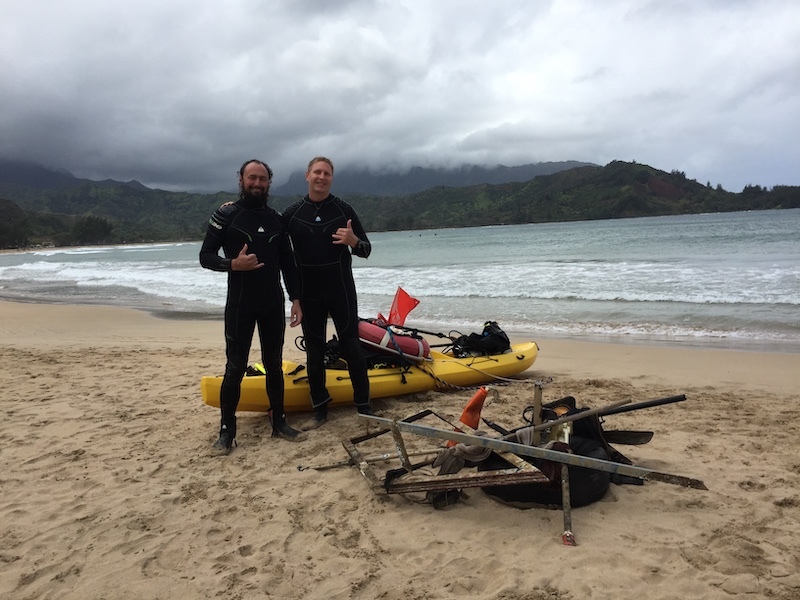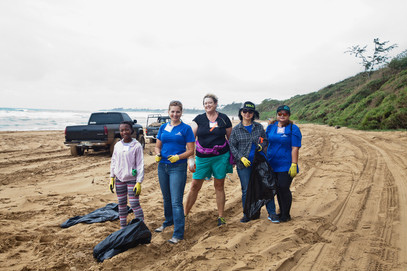| Header Photo: Derelict fishing nets recovered from the Papahānaumokuākea Marine National Monument.
(Photo credit: NOAA)
 Stand with cleanup kits. (Photo credit: Pacific Whale Foundation)
Submitted by: Jens Currie, Pacific Whale Foundation
Since its start in 2015, Pacific Whale Foundation’s Coastal Marine Debris Monitoring Program has grown significantly, and currently distributes 50-100 cleanup kits per week. The kits include a recycled grain bag for the trash and a datasheet for recording what you find. By encouraging members of the community to become citizen scientists, we not only create ocean stewards but also collect important data on the amount and types of debris that ends up on our beaches.
Learn more.
 Divers with removed debris in Hanalei Bay. (Photo credit: Scott Bacon)
Submitted by: Scott Bacon, Malama Na Apapa
Malama Na Apapa, in collaboration with Makana O Kaua‘i Scuba Adventures, has received a grant from the State of Hawaii Workforce Development Council to remove marine debris from waterways and reefs around Kauai. As a direct impact of the historic levels of flooding on Kaua‘i in April 2018, as well as a second flooding event in August from Hurricane Lane, tons of debris washed onto Kaua‘i’s reefs. Debris types that have been removed and discovered, range from household goods to vehicles. The current total for all types of debris removed is 14.65 metric tons.
Learn more.
 Janique Marcil, Jennifer Marcil, Jeanne Haapala, Agnes Haohao, and Eder Ortal pitch in on the coastal marine debris cleanup at Lydgate Beach Park. (Photo credit: Larry Lindsay)
Submitted by: Thomas Noyes, The Friends of Kamalani and Lydgate Park
Kaua‘i’s Lydgate Beach Park serves Līhu‘e and Kapa‘a, the island’s two largest communities. The Friends of Kamalani and Lydgate Park coordinate beach cleanups every Saturday starting at 8:30 AM. On April 20, the Friends celebrated Earth Day in Lydgate Park 2019 with a community workday engaging over 200 volunteers. Join any Saturday beach cleanup or their big community workday October 26—Make A Difference Day 2019—by contacting Tommy Noyes at (808) 639-1018 or thomasnoyes@hawaiiantel.net
Learn more.
 Ho‘ola One microplastic cleanup machine in the field. (Photo credit: Hawai‘i Wildlife Fund)
Submitted by: Mattie Larson, Hawai‘i Wildlife Fund
The Ho‘ola One team from Sherbrook University in Quebec, Canada finally arrived in Kona on April 16th to conduct field-tests of the new microplastic cleanup machine with Hawai‘i Wildlife Fund. The machine was hauled successfully to the north end of Ka‘alu‘alu on April 21st and was tested in the field for an entire week. The machine is currently operational and most all of the systems are working as planned. Please stay tuned for more info and updates!
|